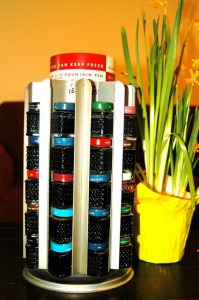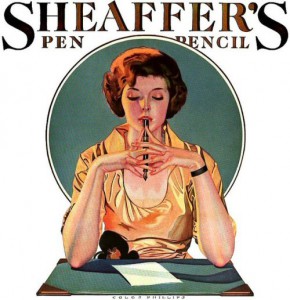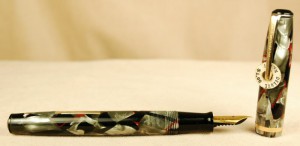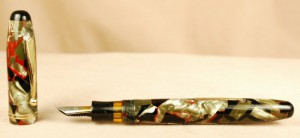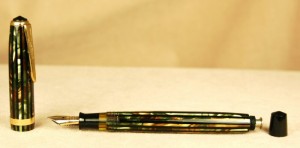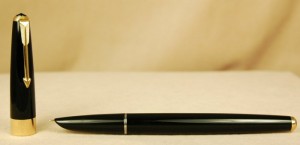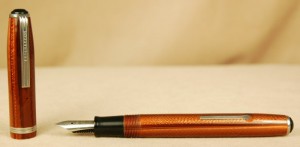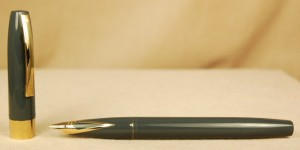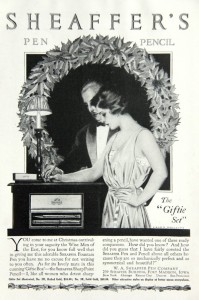Now that veteran vendors and rookie pen collectors are breaking the ice, let’s lend some veteran assistance to the rookies navigating their first pen shows.
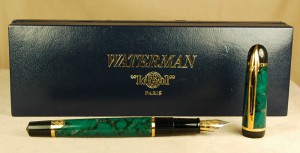 Your first pen show is bound to be an overwhelming affair. There will be tens of thousands, if not hundreds of thousands, of vintage and modern pens. You will find rarities you never dreamed of seeing in the flesh, and you will probably want to spend 10 times the amount of money you intended to spend. Plus, there are all of the custom services, which might take months to get performed through the U.S. mail but you can have satisfactorily completed in a single morning or afternoon at a pen show. And then there are the spare parts, inkwells, papers and cases!
Your first pen show is bound to be an overwhelming affair. There will be tens of thousands, if not hundreds of thousands, of vintage and modern pens. You will find rarities you never dreamed of seeing in the flesh, and you will probably want to spend 10 times the amount of money you intended to spend. Plus, there are all of the custom services, which might take months to get performed through the U.S. mail but you can have satisfactorily completed in a single morning or afternoon at a pen show. And then there are the spare parts, inkwells, papers and cases!
To help you safely navigate your first pen shows, here is some advice that ought to help you breakdown the experience and keep it positive.
PRE-GAME STRATEGY
Set a budget and a goal for the show. Need some repairs done? Want a nib ground to perfection? Looking for certain pens? Organize all that you hope to achieve.
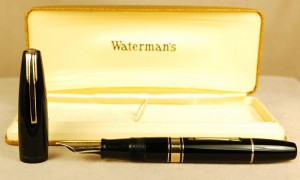 Your best bet is to put together a list of all the things you’re looking for and hope to do. This way you can take some time to marvel at the splendor of the distractions before you check in on your list to focus on your goals.
Your best bet is to put together a list of all the things you’re looking for and hope to do. This way you can take some time to marvel at the splendor of the distractions before you check in on your list to focus on your goals.
Loyal reader Justin P. recommends contacting your favorite eBay and other online vendors to see if they will be at the show. If they are, let them know you can’t wait to see them there and give them a heads up to your list of pens or merchandise that you want. Many will gladly set it aside for you so that you can have first dibs. Plus, it always helps to put names to faces by meeting in person.
Many shows are offering more and more seminars about repairs and the histories of the brands. Check out the show schedule online or in your show pamphlet to see what special events you don’t want to miss. Set an alarm on your phone or watch to help you remember it is time to head over to the seminar. Time passes remarkably quickly, and it is easy to get sidetracked.
If the show offers a weekend pass, you might want to get it. To make the most of the show, it helps to attend all of the days it is open. Day one is your best opportunity to pick up a really rare pen before somebody else snatches it. If it is a 4-day show, days 2 and 4 are quieter days, which are better for meeting new people and asking more questions about the pens and the hobby. Day 3/Saturday will be the busiest day. During trading hours, few vendors will likely want to talk for long because this is their best opportunity to sell the most and pay for their expenses.
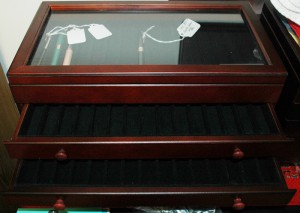 Yet, some of the best times are after the formal trading closes for the day. You’ll often find clusters of vendors and collectors hanging out, talking or getting a drink. Strike up a conversation with them and get to know who they are, what their pen passions are and let them get to know you. Pen People, regardless of their experience with the hobby, are usually very friendly and chatty. People can usually be found talking pens in the lobby of the venue well into the wee hours of the morning.
Yet, some of the best times are after the formal trading closes for the day. You’ll often find clusters of vendors and collectors hanging out, talking or getting a drink. Strike up a conversation with them and get to know who they are, what their pen passions are and let them get to know you. Pen People, regardless of their experience with the hobby, are usually very friendly and chatty. People can usually be found talking pens in the lobby of the venue well into the wee hours of the morning.
SERVICES:
As I don’t do any nib grinding or Mont Blanc piston repair work, I love coming to the shows to take advantage of these services. The trick to navigating these services is to be there the minute the doors to the show open in the morning. If you are one of the first on the repair-person’s list, you can guarantee your pens get done that day.
Be sure to clearly explain to the repair folks what you want done and ask for an estimate first, so you know their prices and aren’t hit with sticker shock. Most repairs are fairly affordable, but it is always best to know what to expect. Vendors won’t mind fixing 2 or 3 pens for you at the show, but don’t expect for them to fix an entire shoebox full of pens at the show. They might ask to take that many pens home with them to work on later.
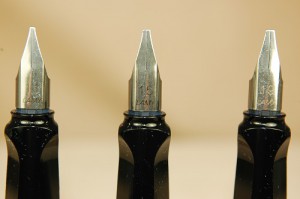 At most shows you can expect to find full-time repair specialists such as Mike and Linda Kennedy of Indy-Pen-Dance, Ron Zorn, Richard Binder and “Mike It Work.” All four of these vendors are nationally known for their excellence. You can’t go wrong with any of them. If you do have 15 to 20 pens you want restored at the show, it might be best to spread 3 or 4 amongst each of them to see who’s work you like best. Expect also a minimum repair bill to be $20 to $25 per pen. It could be up around $40 to $50 if you want your nib ground to a new size and shape.
At most shows you can expect to find full-time repair specialists such as Mike and Linda Kennedy of Indy-Pen-Dance, Ron Zorn, Richard Binder and “Mike It Work.” All four of these vendors are nationally known for their excellence. You can’t go wrong with any of them. If you do have 15 to 20 pens you want restored at the show, it might be best to spread 3 or 4 amongst each of them to see who’s work you like best. Expect also a minimum repair bill to be $20 to $25 per pen. It could be up around $40 to $50 if you want your nib ground to a new size and shape.
If you are having nib work done, be patient and remember it is very precise and time-consuming work. Don’t rush your grinder. However, as you are asking for a very specific and personalized repair, don’t be afraid to say the nib still doesn’t feel right when they ask you to test it. They want you to be happy with their services, and they will work hard to get the precise feel you want in your nib. If they spend an inordinately long amount of time getting your pen just right, they might charge you an extra $5 or $10, which is okay. Time is money, and you will get to enjoy that pen and nib for the rest of your life.
DEALING WITH VENDORS
It came as a great shock to me that not all vendors are there to sell. Some table holders are just there to meet with old friends, show off an impressive collection or to do any number of other things. For most of us, it is a business.
To avoid getting overwhelmed or making rash purchases of the first things you see, spend some time walking around and keeping an eye out for the merchandise on the tables. I like to make a complete sweep of the show before making any purchases…unless I spot something rare that I must buy quickly or not see again.
Don’t be shy. Say hi to the vendors and don’t be afraid to tell them what you’re looking for. It is really easy to overlook the pens you’re looking for on tables that seem lightly populated with pens.
Keep a running tally of prices in your head or on a notepad. It is safe to assume you will find dozens of similar pens at the show. Prices and quality could range all over. Plus, it will help you keep from going over your budget…or show you there is room from an extra new treasure.
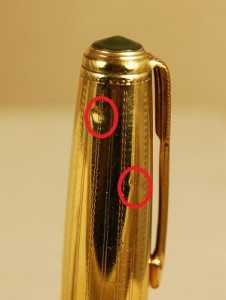 When you are ready to get serious about buying a pen, there is a whole checklist of things to do:
When you are ready to get serious about buying a pen, there is a whole checklist of things to do:
- ASK the vendor if you can pick up and examine his or her pen (You’d be surprised at how many people break pens or inadvertently mess up an organizational system.)
- Look over the pen carefully for cracks, dents, imprint quality and brassing
- ALWAYS try first to UNSCREW the cap. NEVER YANK on a cap.
- Search for cracks on the lip of the cap with your thumbnail. If you spin the lip of a cap over your thumbnail, it will gently pick up any crack that might not be visible to the eye.
- Use a loupe to examine the nib. Are there cracks? Is the tipping good? Are the tines aligned? Are one of the tine tips cracked just below the tipping and about to pop free?
- If the nib looks okay, then test it for flex with your thumbnail. Put the underside of the nib’s tip on the top of your thumbnail and gently add pressure.
- ASK if you can test the filling system. If you feel any pressure or resistance in the filling system, don’t force it. Ask the vendor if it needs restoration? (Lots of vendors complain about people breaking levers and other pen parts while checking out the filling system.)
- Finally, ask if the vendor has ink and if you can dip the pen to try it out.
CLOSING THE DEAL
Cash is king. All pen dealers accept cash. However, many are now accepting credit cards due to the simplicity of smart phones and apps by Square and PayPal.
Before you start negotiating the final price, ask if they accept credit cards…if that is all you have with which to pay. This might save everybody some time and trouble. Don’t be upset if they say yes but also tack on an extra 2% or 3% to cover the fee charged by the credit card company. Some deals run the profit margin pretty thin, and it is fair to pay the processing fee.
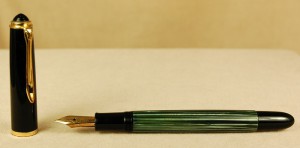 To negotiate a deal well, it helps to be well informed about the pen you are buying and its current prices. Be sure to highlight any flaws in the pen and make an offer that is fair and realistic. Don’t be afraid to walk away from a deal that is still too high for you. Yet, don’t be afraid to accept a counter offer that is reasonable, especially if you received good customer service.
To negotiate a deal well, it helps to be well informed about the pen you are buying and its current prices. Be sure to highlight any flaws in the pen and make an offer that is fair and realistic. Don’t be afraid to walk away from a deal that is still too high for you. Yet, don’t be afraid to accept a counter offer that is reasonable, especially if you received good customer service.
Many vendors don’t put prices on their pens. Some of them like to game you a bit to see how much you are willing to pay. Let’s say you’re looking at an aerometric Parker 51 in black with a lustraloy cap. You ask how much, and the vendor replies $100. It’s okay to smile, say thanks and put it back down. Unless it has something rare like a stub nib or some other uncommon feature, he or she will likely counter, “Well how much were you hoping it would be?” You can honestly say–because you know there are 3 bajillion black 51s in the world–that you were hoping for around $50. The vendor will likely acquiesce with something like, “Well, I can do $55.”
Feel free to ask vendors lots of questions, BUT understand that they might expect you to buy something if you take up too much of their time. If you have tons of questions, but aren’t ready to buy, save them until you are with a vendor whose pens you will be buying or until the show slows down and the vendor has more free time to talk.
And, of course, if you do get a cranky vendor who doesn’t treat you as you feel you should be treated, just move on to the next. There are often well over 100 vendors at most shows, and somebody nice will likely have just what you’re looking for.
Have fun!
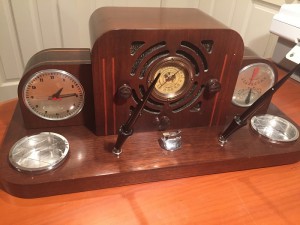
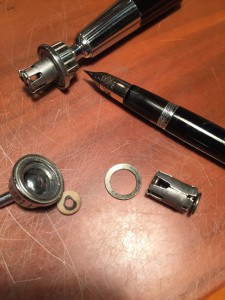


 Shopping Cart
Shopping Cart










